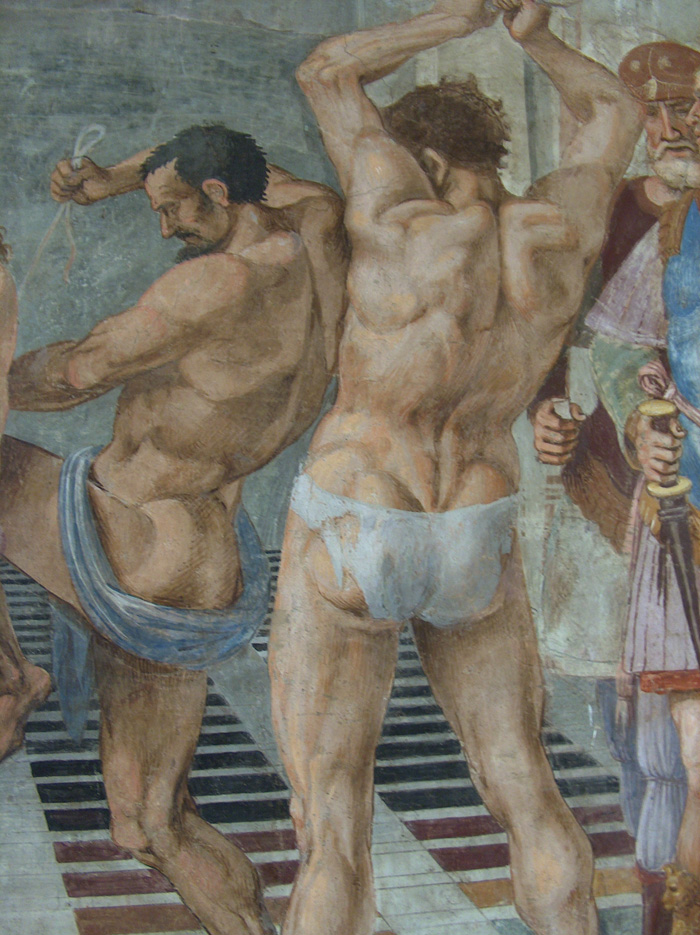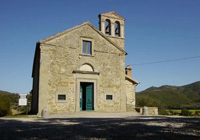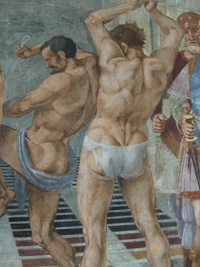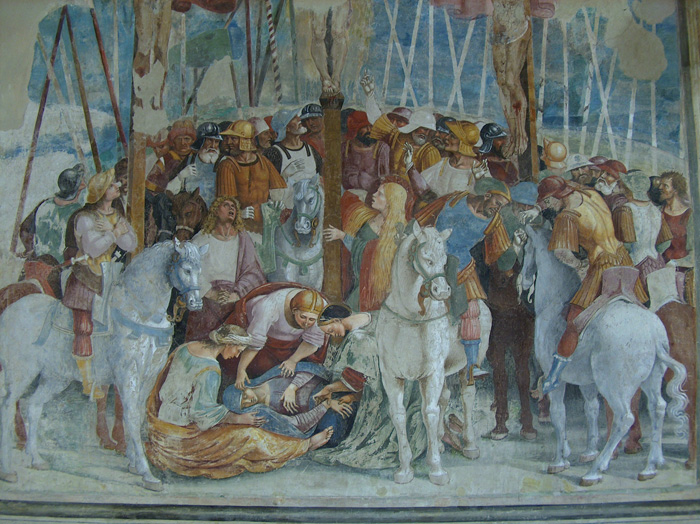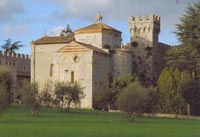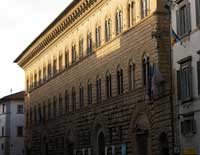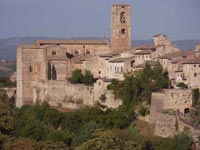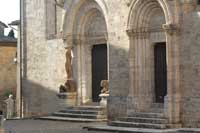| |
|
History
The town may have been Etruscan; the Romans knew it as Tifernum Tiberinum ("Tifernum on the Tiber")[1] or Civitas Tiberina. Just nearby, Pliny the Younger built his villa in Tuscis, which is identified with walls, mosaic floors and marble fragments surviving at a place now called Colle Plinio, the "Hill of Pliny".
In 550, Tifernum was largely destroyed during the Ostrogothic campaign by Fantalogus, at the orders of Totila. The town was subsequently rebuilt by its bishop, Floridus, around a castle, and renamed first Castrum Felicitatis and later Civitas Castelli. By the Donation of Pepin of the Frankish king Pepin the Short in 752, it went to the Holy See, though in practice it was disputed between the papacy, Perugia and Florence. It was ruled by the Vitelli family, even after Cesare Borgia attached the city more directly to the Holy See.
In subsequent centuries, it had various rulers, among them Pier Saccone Tarlati di Pietramala, brother of Guido, Bishop of Arezzo. Pier Saccone sold it in 1322 to Guido Alberto de' Guidi di Modigliana. In the later Middle Ages it was governed successively by the Guelphs and Ghibellines. In 1375, Città di Castello joined the insurrection of other cities of the States of the Church. Cardinal Robert of Geneva (later antipope as Clement VII), tried to capture it using Breton mercenaries, but was repulsed. Under Pope Martin V in 1420, it was taken by the condottiero Braccio da Montone. Later Niccolò Vitelli, aided by Florence and Milan, became absolute ruler or tiranno. Antonio da Sangallo the Younger built an extensive palace for the Vitelli family.
In 1474, Sixtus IV sent his nephew, Cardinal Giuliano della Rovere (later Julius II); after fruitless negotiations he laid siege to the city, but Vitelli did not surrender until he learned that the command of the army had been given to Duke Federico III da Montefeltro. The following year Vitelli tried unsuccesefully to recapture the city; fear of Cesare Borgia induced him to desist, since Cesare Borgia had his father strangled and Città di Castello added to the papal possessions.
Towards the end of the twentieth century, the city has seen a considerable expansion northwards toward San Giustino, with industrial parks tracking the river, railroad and main highway: the area produces farm machinery, textiles, ceramics and furnishings.
|
Map
|
|
| |
| Fractions
Antirata, Astucci, Badiali, Badia Petroia, Barzotti, Baucca, San Martino d'Upò, Belvedere, Bisacchi, Bonsciano, Caifirenze, Candeggio, Canoscio, Capitana, Celle, Cerbara, Cinquemiglia, Colcello, Coldipozzo, Cornetto, Croce di Castiglione, Fabbrecce, Fiume, Fraccano, Grumale, Lerchi, Lugnano, Madonna di Canoscio, Marchigliano, Montemaggiore, Monte Ruperto, Morra, Muccignano, Nuvole, Palazzone, Petrelle, Piosina, Promano, Riosecco, Roccagnano, Ronti, Rovigliano, San Leo Bastia, San Biagio del Cornetto, San Lorenzo Bibbiana, San Maiano, San Martin Pereto, San Martino di Castelvecchio, San Pietro a Monte, San Secondo, Santa Lucia, Scalocchio, Seripole, Terme di Fontecchio, Titta,Trestina, Uppiano, Userna, Userna Bassa, Valdipetrina, Vallurbana, Vingone, Volterrano. |

Bibliografia
Luca Signorelli a Morra in Rivista d'arte, Volumi 26-27, Leo S. Olschki, 1950
Giuseppe Nicasi, Dei segni numerici usati attualmente dai contadini della valle del Morra nel territorio di Città di Castello, Perugia 1906
Dana Facaros, Michael Pauls Morra in Cadogan Guide Umbria, New Holland Publishers, 2006 p. 122
|

Museo del Duomo di Città di Castello | www.museoduomocdc.it
The first Cathedral Museum occupied just two rooms (about 60 sq.m.) with access from the Basilica of St. Florido and St. Amanzio; in one room liturgical vestments were displayed, in the other there were paintings and silver vessels.
On 23 March 1991 larger, re-designed premises were opened consisting of some seven rooms (about 430 sq.m.) on two floors. Some of these rooms had been part of the 16th and 17th century sacristies, while others were of much earlier construction dating from 13th and 14th centuries.
The present building inaugurated on 18th March 2000, constitutes the most extensive Museum of sacred artefacts (800 sq.m.) in the whole of Italy. All its twelve rooms and galleries, including a noble Gothic hall of majestic proportions, are the result of painstaking and meticulous restoration in order to reveal their original form and character.
Depliants
| Museo del Duomo
Collezioni Burri di Città di Castello
Pinacoteca Comunale di Città di Castello
Percorso dei Musei della Civiltà Contadina
Percorso Museale del Tessile e del Ricamo
Percorso museale dell'arte tipografica
Proloco Morra | www.prolocomorra.it
|
| |

|
| |
|
|
|
|
|
Podere Santa Pia, garden |
|
Podere Santa Pia |
|
Abbadia d’Ombrone and Monastero d’Ombrone near Castelnuovo Berardenga. |
| |
|
|
|
|
|
|
|
|
|
Palazzo Medici Riccardi, Florence |
|
Colle di Val d'Elsa |
|
Florence, Duomo
|
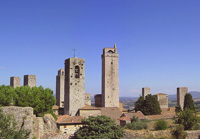 |
|
|
|
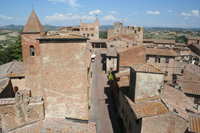 |
San Gimignano
|
|
San Quirico d'Orcia |
|
Certaldo |
| Anghiari |
|
|
|
|
On 29 June 1440, the plain in front of Anghiari was the scene of a famous battle, which went down in history as the Battle of Anghiari, between the Florentine allies of the Holy See on the one hand, and the Milanese on the other Few people were killed, but the victory in Tuscany resulted in the reduction of territorial ambitions in Lombardy. Leonardo da Vinci, at the request of the Florentine government, immortalized this event, painting this historic battle in the Palazzo Vecchio in Florence. Unfortunately, only a few copies remain today, including a Rubens, now preserved at the Louvre Museum in Paris. Anghiari, in addition to the beautiful churches, also has important museums: The Palazzo della Battaglia, or the Museum of Memory and the Landscape in the Land of Anghiari, and the State Museum of Palazzo Taglieschi. The Museum of the Battle of Anghiari, offers the opportunity to learn about the history of the battle and the artistic heritage of Leonardo to this place. The Taglieschi Museum, houses important artistic works of great historical value, frescoes from churches and palaces of the region, a wooden polychrome Madonna by Jacopo della Quercia, and Robbia pottery.
|
|
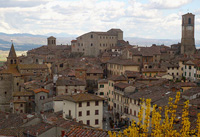 |
Sansepolcro
|
|
|
| |
|
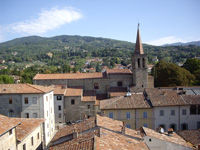
|
Questo articolo è basato sugli articoli Sansepolcro, Torre di Berta, Museo civico (Sansepolcro), Pala di Sansepolcro, Bartolomeo della Gatta e Resurrezione e Noli me tangere dell' enciclopedia Wikipedia ed è rilasciato sotto i termini della GNU Free Documentation License.
Wikimedia Commons contiene file multimediali su Duomo (Sansepolcro) e Resurrezione (Piero della Francesca).
|
 |
|
| |
| |
|
|
|
|
![]()
![]()
![]()
![]()
![]()

